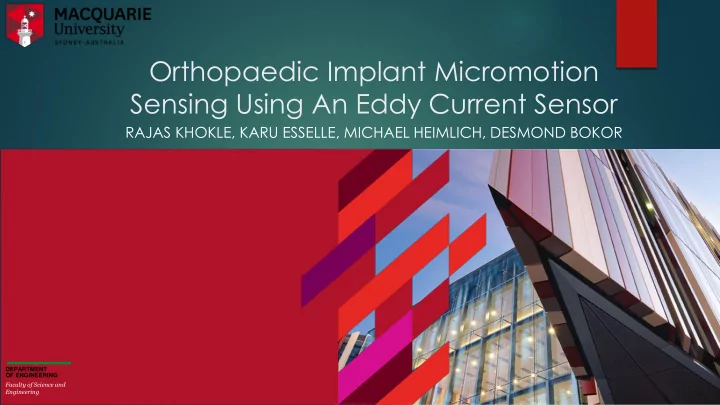

Orthopaedic Implant Micromotion Sensing Using An Eddy Current Sensor RAJAS KHOKLE, KARU ESSELLE, MICHAEL HEIMLICH, DESMOND BOKOR DEPARTMENT OF ENGINEERING Faculty of Science and Engineering
Motivation - Problem In Australia, till 2016, about 1.1 million people had Orthopaedic surgeries. Out of these, about 100K were revision surgeries. In 85% of the cases the major cause of the revision is the Aseptic Loosening and mechanical failure whereas remaining 15 % is due to infection. This causes a substantial a) Financial burden on healthcare system and b) Physical discomfort to the patient.
Motivation - Solution Measure micro motion of the implant on bone 50μm motion is the threshold for decreased bone ingrowth. Detect impending failure of the implant Modify post-operative mobilisation to allow for better bone ingrowth if there is excessive initial motion Need to Develop a Small Implantable Non-contact Micromotion Sensor with the Resolution of 10 m.
Modelling in Ansys HFSS A cylindrical hole of diameter 3 mm and length 15 mm is drilled into the tibial bone at a distance D from the tibial implant (target). A two-turn loop is printed on Rogers RT Duroid 6010 substrate and inserted into the hole. The sensor head is encapsulated in a low loss biocompatible material, PEEK. This entire assembly is inserted in a cylindrical muscle phantom of diameter 120mm. How does the Impedance of the eddy current loop changes with a) Distance D between Tibial plate and sensor. b) Frequency of Operation
Simulations Results - 1 At 10 MHz, the response of the eddy current sensor shows a typical behaviour in which inductance increases with the distance while resistance decreases and correspondingly Q Factor increases. We perform curve fitting Sensitivity is distance dependant !!! on these graphs in the form 𝑧 = 𝑏𝑦 𝑐 + 𝑑
Defining Analysis Parameters Sensitivity is defined as the relative change in the measured quantity y expressed in dB for 10 m displacement of the target . ∆𝑧 𝑇 10 𝑛 = 10 𝑚𝑝 10 𝑧 Sensitivity range is defined as the distance between target and sensor at which the sensitivity drops to ‘ x ’ dB. While first definition allows for analysing what is the sensitivity at given standoff distance, the second parameter is useful for working out the stand-off distance given the limitations of the designed circuit.
Simulations Results - 2 As frequency increases the inductance sensitivity also increases. However, the change is very prominent in the vicinity of Self Resonant Frequency (SRF) of 920 MHz. The graph for resistance shows that sensitivity has a null around 200 MHz and an optimum value in the range of 20-50 MHz. The Sensitivity peaks at SRF. Q factor follows nature of resistance.
Simulations Results - 2 @ 20 MHz 30 dB 40 dB 50 dB Inductance 1.25 mm 2.54 mm 5.6 mm Resistance 1.63 mm 3.15 mm 6.1 mm Q Factor 1.86 mm 3.57 mm 7.0 mm
Simulations Results - 3 Most of the power is lost in Tibial tissue. Power Loss in Human body starts manifesting beyond 1 GHz. After 500 MHz, more than 50 % power is lost in tibial tissue. About 2-5 % power is lost in substrate and PEEK encapsulation.
Experimental Setup
Experimental Results – 20 MHz ➢ Resistance offers an order of magnitude higher sensitivity than Inductance. ➢ The sensitivities match fairly well with the simulation results.
Conclusion We developed a good and reliable simulation strategy for Eddy current sensor implanted inside bone. As the standoff distance increases, the sensitivity of all the parameters decreases. This is also seen in the simulations. As the standoff distance changes from 5 mm to 15 mm, the sensitivity changes almost by an order of magnitude. The resistance offers higher change as opposed to the inductance. It is higher by an order of magnitude than inductance. This is also reflected in the Q factor. It may not be practical to have standoff distance higher than 5 mm to get the resolution of 10 m.
Thank You !
Reason for dip in the resistance curve
Rate of revision 100% 48502 3338 57819 536 376 90% 80% 70% 60% 50% 544075 29068 440841 2738 1662 40% 30% 20% 10% 0% Hips Knee Shoulder Ankle Wrist Primary Revision
Rate of revision – Australian JRR
Rate of revision – USA JRR
Recommend
More recommend